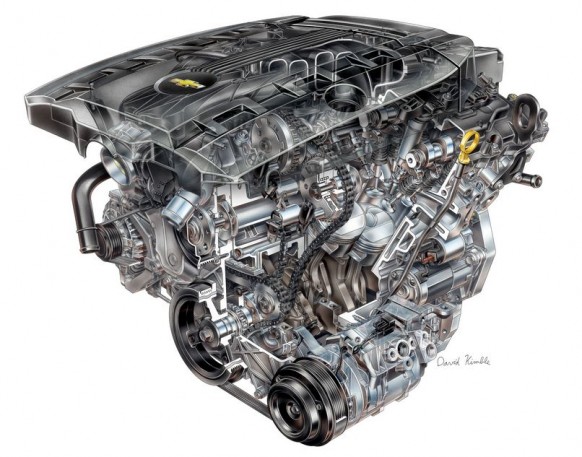Noticed the wiki page didn't have some engine data for the LFX like it does for the LLT, LS3 and L99.
Just some food for thought if someone wants to update it. Sources are listed at the bottom.
The LFX is an enhanced version of the LLT engine. Introduced in the 2012 Chevrolet Camaro LS, it is 20.5 pounds (9.3 kg) lighter than the LLT, due to a redesigned cylinder head and integrated exhaust manifold, and composite intake manifold. Other components like the fuel injectors, intake valves, and fuel pump have also been updated. Power and torque are up slightly from the LLT. The compression ratio is 11.5:1.
What gives the LFX more mojo for the 2012 Camaro can be credited towards several mechanical improvements, including a new cylinder head design with an integrated exhaust manifold, an improved intake port design and larger intake valves within the cylinder heads. We also see a new fuel pump system and isolated fuel rail, new fuel injectors and a composite intake manifold. Rounding out the improvements are stronger, lighter connecting rods, a camshaft cap and throttle body design enhancements.
2012 Chevrolet Camaro 323 hp (241 kW) @ 6800 rpm 278 lb·ft tq(377 N·m) @ 4800 rpm

The LFX engine is significantly lighter than the current 3.6L V-6. The integrated cylinder head/exhaust manifold design saves approximately 13 pounds (6 kg) per engine over the cylinder heads and manifolds of the current engine, while the new composite intake manifold saves approximately 5.5 pounds (2.5 kg) over the current aluminum intake. Additionally, a lighter-weight structural front cover and lighter-weight, high-strength connecting rods bring the total weight savings to 20.5 pounds (9.3 kg), which helps the vehicle’s fuel efficiency and enhances its feeling of driving balance.
Additionally, the optimized-flow fuel injectors and integrated exhaust manifolds/cylinder heads promote lower emissions. And along with its weight savings, the composite intake manifold has a smaller radiated surface area to help it maintain noise and vibration characteristics comparable to the previous aluminum manifold.
Greater airflow brings more power. The new cylinder heads also bring a revised intake port design that enhances airflow to the combustion chambers. Larger-diameter intake valves (38.3 mm vs. 36.96 mm) are used in the heads and work in conjunction with new, longer-duration intake camshafts to provide the engine’s boost in horsepower.
The valves let air in and exhaust escape from the combustion chambers. The duration of the camshaft determines how long the valves are open. By using larger valves and holding them open longer, more of the air is pulled into the combustion chamber, for a more powerful combustion. Often, the tradeoff for greater power is greater fuel consumption, but the LFX engineers adapted new fuel injectors that are optimized for the engine’s performance parameters. The result is more power without sacrificing fuel economy. The more-efficient combustion also means reduced emissions.
Of course, the LFX engine retains direct fuel injection. It optimizes fuel delivery to the combustion chamber by introducing fuel closer to the combustion chamber. The result is better efficiency in the combustion process leading to increased fuel efficiency at part and full throttle.
The LFX uses a new fuel pump for the direct injection system, along with a new, isolated fuel rail. The new fuel pump is quieter, while the isolated fuel rail further reduces fuel system noise.
Sources:
gmauthority.com
wikipedia.com
hfv6.org